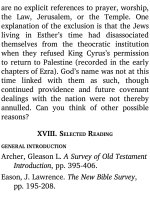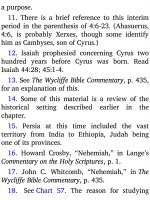Jensens survey of the old testament adam 171
Bạn đang xem bản rút gọn của tài liệu. Xem và tải ngay bản đầy đủ của tài liệu tại đây (117.78 KB, 4 trang )
Much of the book is addressed especially to
young people (e.g., 1:4, 8). The proverbs are
mainly about personal ethics, not as the
sinner’s way to God, but as the believer’s
walk with God on this earth. Although the
book is not intended to elaborate on the way
of salvation, such key phrases as “the fear of
the LORD” (1:7) tell basically how a sinner is
brought into fellowship with God. The
counsel of Proverbs is pro table for all
people—saved
and
unsaved—but
the
unsaved do not gain salvation by attempting
to perform its good deeds (cf. Eph 2:8-9).
C. VARIETY OF ILLUSTRATIONS AND APPLICATIONS
The list of di erent subjects written about
in Proverbs seems endless. Here are some
examples:13
Topics: wisdom, sin, tongue, wealth, pride,
idleness, love, pleasure, success,
temperance, morals
Contrasting subjects: God and man; time and
eternity; truth and falsehood; wealth and
poverty; purity and impurity; justice and
injustice; pleasure and misery
Evil people: prating fool; talebearer;
whisperer; backbiter; false boaster;
speculator
Social relations: master and servant; rich and
poor; husband and wife; parents and
children
VI. KEY WORDS AND VERSES
Study the list of key words shown on
Chart 73. Also read the key verses in the
Bible text. There are other verses which
could serve as key verses.
VII. APPLICATIONS
The book of Proverbs is
lled with
commands and exhortations about daily
conduct. The reader has hardly begun
reading the book when he is confronted with
such words as “If sinners entice you, do not
consent” (1:10). God knew that His people
would need to be reminded again and again
about how to think, speak, and act, so He
inspired the writing and collection of
Proverbs.
Here are some suggestions for interpreting
the maxims of Proverbs, leading to
application:
1. Recognize that the proverbs are
instructions from the Lord, not mere secular
maxims. It is very signi cant that the name
“LORD” (Jehovah) appears eighty-six times in
the book.
2. Interpret “wisdom” in the book as
representing righteousness, or holiness, which
describes the heart of that person who truly
knows God. Likewise, interpret such words
as “fool” and “folly” as representing
wickedness of the unsaved man.
3. Recognize the device of personi cation
whenever it appears in the book. For
example, the foolish woman of 9:13-15 is
not primarily an individual person as such,
but spiritual folly, or wickedness (the opposite
of spiritual wisdom, or righteousness).
4. Let the surrounding verses shed light
on a proverb when its meaning is unclear.
However, because of the miscellaneous
character of the listings of many proverbs, it
may be necessary to refer to more distant
verses (e.g., in another chapter or even in
another book) where a similar phrase
appears, for its clari cation. (For example,
the phrase “strange woman” in 20:16 KJV, is
partly explained by 2:16.) An exhaustive
concordance is a valuable help here.
5. When the most obvious interpretation









